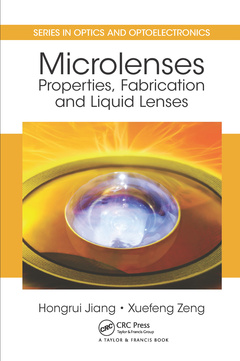Description
Microlenses
Properties, Fabrication and Liquid Lenses
Series in Optics and Optoelectronics Series
Authors: Jiang Hongrui, Zeng Xuefeng
Language: English
Subjects for Microlenses:
Keywords
Microlens Arrays; Focal Length; Mechanically tunable microlenses; Applied Physics Letters; Electrically tuned microlenses; Liquid Lens; microlenses in optical communications; Contact Angle; Non-tunable microlenses; Spherical Aberrations; liquid-based microlenses; Fresnel Lenses; microscale fabrication methods; Refractive Index; Horizontal microlenses; PDMS Layer; labs-on-chips; Real Time Optical Coherence Tomography; liquid microlenses; Static Air Liquid Interfaces; microfabrication techniques; Compound Eyes; physics behind microlenses; Confocal Reflectance; Transverse Spherical Aberration; Ge QDs; Ni Stirrer; Junction J3; Etch Rate; Flow Rate Ratio; Longitudinal Spherical Aberration; Artificial Implementation; Dielectric Force; SEM Image; Optical Coherence Tomography; Lens Array
Publication date: 06-2020
· 15.6x23.4 cm · Paperback
Publication date: 04-2013
228 p. · 15.6x23.4 cm · Hardback
Description
/li>Contents
/li>Readership
/li>Biography
/li>
Due to the development of microscale fabrication methods, microlenses are being used more and more in many unique applications, such as artificial implementations of compound eyes, optical communications, and labs-on-chips. Liquid microlenses, in particular, represent an important and growing research area yet there are no books devoted to this topic that summarize the research to date. Rectifying this deficiency, Microlenses: Properties, Fabrication and Liquid Lenses examines the recent progress in the emerging field of liquid-based microlenses.
After describing how certain problems in optics can be solved by liquid microlenses, the book introduces the physics and fabrication methods involved in microlenses. It also details the facility and equipment requirements for general fabrication methods. The authors then present examples of various microlenses with non-tunable and tunable focal lengths based on different mechanisms, including:
- Non-tunable microlenses: Ge/SiO2 core/shell nanolenses, glass lenses made by isotropic etching, self-assembled lenses and lens arrays, lenses fabricated by direct photo-induced polymerization, lenses formed by thermally reflowing photoresist, lenses formed from inkjet printing, arrays fabricated through molding processes, and injection-molded plastic lenses
- Electrically tuned microlenses: liquid crystal-based lenses and liquid lenses driven by electrostatic forces, dielectrophoretic forces, electrowetting, and electrochemical reactions
- Mechanically tunable microlenses: thin-membrane lenses with varying apertures, pressures, and surface shapes; swellable hydrogel lenses; liquid?liquid interface lenses actuated by environmentally stimuli-responsive hydrogels; and oscillating lens arrays driven by sound waves
- Horizontal microlenses: two-dimensional polymer lenses, tunable and movable liquid droplets as lenses, hydrodynamically tuned cylindrical lenses, liquid core and liquid cladding lenses, air?liquid interface lenses, and tunable liquid gradient refractive index lenses
The book concludes by summarizing the importance of microlenses, shedding light on future microlens work, and exploring related challenges, such as the packaging of systems, effects of gravity, evaporation of liquids, aberrations, and integration with other optical components.
Introduction to Liquid Microlenses. Basic Physics of Microlenses. Fabrication Methods. Solid Microlenses. Electrically Driven Tunable Microlenses. Mechanically Driven Tunable Microlenses. Horizontal Microlenses Integrated in Microfluidics. Looking into the Future. Index.
Hongrui Jiang and Xuefeng Zeng are with the University of Wisconsin–Madison.
These books may interest you

Introduction to Adaptive Lenses 128.91 €

Modern Ophthalmic Optics 92.79 €


